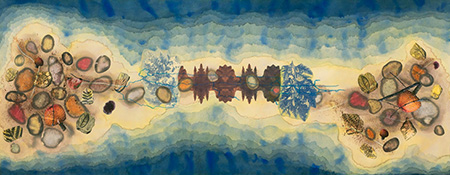
Continuing through October 22, 2022
The Mississippi River is in Liz Ward’s blood. Born in New Orleans, her grandfather worked on the river as a steamboat captain. She is now based in San Antonio and spends her summers in rural Michigan. All of her work is informed by the natural world, but river imagery has been a dominant and consistent theme. In 2019, she produced “Floating Life,” a series of 15 large drawings inspired by maps created by Harold Fiske in the 1940s. Like these maps, Ward’s pieces depict the meandering paths of the Mississippi over time and resemble intertwining ribbons of color.
“Silver River” is the title not only of the current exhibition, but of the largest of the 14 mixed-media paintings. All are executed on indigo Japanese paper, which is so delicate that it must be mounted on another sheet of paper before being framed. Ward slowly builds up the complex surface by layering watercolor and gouache with drawing and nature printing using leaves dipped in silver and butterflies dipped in gold. The Mississippi River traverses the surface horizontally as a wandering ribbon of silver metallic ink. Using white chalk and white conté on the dark surface, Ward outlines the bell-shaped flowers of the Indian pipe plant, also known as the ghost plant, below the silhouettes of two men standing on a rough-hewn raft. They float below a starry sky reflected in the river, which is represented by concentric circles of dotted lines. In speaking about the piece, Ward refers to Walter Johnson’s book, “River of Dark Dreams: Slavery and Empire in the Cotton Kingdom,” in which he writes about how the Mississippi River served as an escape corridor for slaves going north.
Three pieces incorporate wax-crayon gravestone rubbings made by the artist. “In Memory Of” commemorates a man killed in the Copper Falls Mine in Mellen, Wisconsin, in the early 1900s. “Daily Labor” is in memory of William Roberts, who also died in a mining accident. The area was a source of iron ore, but operations ceased around 1930. The two graves seem to float under a weeping willow tree and above a river lined with pines.
For Ward, making art is a “mode of inquiry,” a way to order her thoughts and “create something visually engaging to express those ideas to other people.” The layers in her work reflect her ongoing research into mythology, culture, and environmental science, as well as her personal experiences. In a large vertical piece, “Strangler Fig,” she investigates a species of plant that surrounds a tree and sucks out the nutrients until it dies, resulting in a “tree” with a hollow central core. For “Rock Harbor,” Ward covered Japanese paper with transparent washes of cerulean watercolor surrounding a sand bar on which she painted rocks in delicate shades of gray, beige, and even red. The final step was to attach to the surface small drawings of plants cut from various publications. There is a serenity to these pieces that expresses the artist’s patience and sensitivity to her materials. The result is placid and mesmerizing, much like a day spent immersed in nature.
